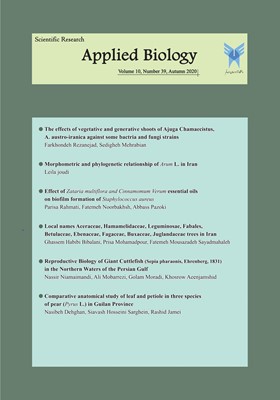-
-
List of Articles
-
Open Access Article
1 - The effects of vegetative and generative shoots of Ajuga Chamaecistus, A. austro-iranica against some bactria and fungi strains
Farkhondeh Rezanejad Sedigheh Mehrabian -
Open Access Article
2 - Morphometric and phylogenetic relationship of Arum L. in Iran
Leila Joudi -
Open Access Article
3 - Effect of Zataria multiflora and Cinnamomum Verum essential oils on biofilm formation of Staphylococcus aureus
Parisa Rahmati Fatemeh Noorbakhsh Abbass Pazoki -
Open Access Article
4 - Local names Aceraceae, Hamamelidaceae, Leguminosae, Fabales, Betulaceae, Ebenaceae, Fagaceae, Buxaceae, Juglandaceae trees in Iran
Ghassem Habibi Bibalani Prisa Mohamadpour Fatemeh Mosazadeh SayadMahaleh -
Open Access Article
5 - Reproductive Biology of Giant Cuttlefish (Sepia pharaonis, Ehrenberg, 1831) in the Northern Waters of the Persian Gulf
Nassir Niamaimandi Ali Mobarrezi Gholam Moradi Khosrow Aeinjamshid -
Open Access Article
6 - Comparative anatomical study of leaf and petiole in three species of pear (Pyrus L.) in Guilan Province
Nasibeh Dehghan Siavash Hosseini Sarghein Rashid Jamei
-
The rights to this website are owned by the Raimag Press Management System.
Copyright © 2021-2025







